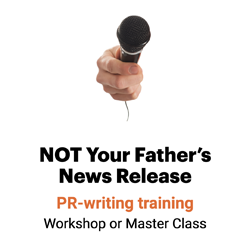Just 3% to 45% of releases actually get the word out
PR professionals have been married to the traditional PR writing approach since Ivy Lee created the news release more than 100 years ago.

Why, then, do we need a new approach?
With an estimated 3,000 releases going out over the wires each day — that’s one every 29 seconds — the impact of your traditional PR piece ain’t what it used to be.
In fact, fewer than 50% of all traditional PR pieces ever get covered, according to PR Newswire’s own research. Dennis L. Wilcox and Lawrence W. Nolte, authors of Public Relations Writing and Media Techniques, go further. They estimate that some 55% to 97% of all PR pieces sent to media outlets are never used.
Why?
What’s wrong with releases?
Most news releases are:
1. Irrelevant
Most journalists receive more than 50 releases a day, according to a survey by Greentarget. But those releases aren’t useful to their target audiences:
- Most trade magazine editors surveyed said fewer than half of the releases they receive are relevant to their publication, according to a survey by Thomas Rankin Associates.
- 65% to 75% of city editors surveyed believed press releases promote “products, services and other activities that don’t legitimately deserve promotion,” write Wilcox and Nolte.
- No wonder journalists’ biggest pet peeves are releases that don’t pertain to their beats or aren’t relevant to the audiences they serve, according to the Greentarget survey.
“I recently got a message from a reporter working at a small local paper who received 80 press releases in one day,” says Jeremy Porter, digital communications strategist. “Of them, only two were relevant to the information his paper covers.”
2. Poorly written
Most PR pros are bad at pitch writing, according to a study by New York-based DS Simon Productions.
- Television news professionals reported that only 41% of the pitches they receive are good.
- Those TV journalists say that only 33% of the PR people they work with are knowledgeable about the program they’re pitching.
- And pitches are getting “significantly worse” than they used to be, according to 22% of the reporters, editors and analysts surveyed in a Softletterpoll.
Entry-level PR pros are worse, according to a study by Michigan State University and Calgary’s Mount Royal University.
In the study, more than 950 members of the Public Relations Society of America and the Canadian Public Relations Society gave PR pros with five or fewer years of experience failing grades in writing skills.
That’s too bad. Because writing tops the list of five essential PR skills, according to Wilcox.
3. Ineffective
As a result, according to Greentarget, journalists turn to other sources for stories:
- 68% of journalists surveyed by Greentarget get their story ideas from sources.
- 41% get ideas from other news outlets.
- Just 34% get them from releases.
Write better releases.
But a well-written release can help you gain media coverage, reach clients and customers directly, get shared as social media content and draw more visitors to your site.
So how can public relations professionals and PR firms write releases that are among the 3% to 45% of those that actually get the word out? Write releases that:
- Are relevant and valuable to the journalist and her readers. Focus on “news you can use to live your life better” and tipsheets and other value-added story angles.
- Tell a story instead of just reporting facts. The traditional news release format, with its terse hierarchical blurtation of facts, is so tedious and dry, it makes folks’ eyes glaze over.
- Make it easy to read and use. Subheads, bullets and other display approaches make details easier for the reporter to read. Multimedia elements make the release easier to use.
Good public relations writing is good strategic communication.

Leave a Reply